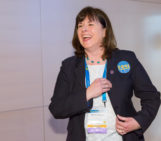
We cannot solve the world’s most complex problems, from climate change to curing disease, if we demand that our brilliant minds leave parts of themselves at the laboratory door. This is the fundamental truth we must acknowledge in Science, Technology, Engineering, and Mathematics (STEM). The demand for conformity, the fear of judgment, and the reality of discrimination act as invisible barriers that stifle innovation and push talent away. That is why we still need the International Day of LGBTQIA+ People in STEM.
My name is Lisa, and since today marks the international day of LGBTQIA+ people in STEM, I want to explore the intersection of identity and innovation in the scientific world. I am a postdoctoral researcher at LMU. After completing my Ph.D. where I focused on photoactivatable first-row transition metal complexes for anticancer therapy, I am currently working on DNA mimics-proteins interactions to deepen my knowledge about biophysics. When I show up to work, I don’t only show up as a scientist: I am also a queer woman dedicated to making our scientific community as inclusive as it should be.
Why do we still need an observation day for LGBTQIA+ in STEM?
In fields that pride themselves on objectivity, why do we need a specific day to highlight, celebrate, and advocate for queer people?
The simple answer is that the labs, universities, and tech companies of the world are not immune to the same societal biases and structural barriers that exist everywhere else. We might be searching for the next scientific breakthrough, but we are still human, and our institutions still struggle with inclusion. For me, the work I do is everything. I want every ounce of my energy focused on solving tough scientific problems. But when you spend mental energy worrying about whether a new colleague will be accepting, or if mentioning your partner is “professional,” that focus is fractured. That is why this day matters: it forces a spotlight onto the issues of visibility, retention, and psychological safety for every LGBT+ person contributing to STEM.
My journey as a postdoctoral researcher in chemical biology, a queer woman in science, has given me a direct view into the complexities of identity within academic STEM. While I’ve been fortunate that my queer identity has not been the primary source of obstacles since I live in a country where LGBTQIA+ rights are somewhat protected; people just seemed to know I was a lesbian, and I never felt pressure to hide it, and I have certainly faced challenges tied to being a woman in science.
Sometimes, I could feel that my ideas were not taken very seriously. When you’re perceived as a woman, what you say can always be questioned. For example, I’ve supervised male interns who systematically double-checked my advice with a man. While verifying information is always good, systematically doubting a woman’s word is a different issue. Most of the time, this sexism is internalized: very few people realize that they behave differently depending on the other person’s gender. The more we advance in our scientific careers, the more this issue becomes apparent, as the proportion of women decreases.
I’ve noticed that labs lacking diversity, whether in gender, nationality, or background, are not the ones where scientific discussions thrive. In very hetero-masculine contexts, people tend to promote themselves rather than listen, interrupt others, and dominate discussions. It is exhausting for minorities to fight for a voice. That’s unfortunate, because taking advice from others is what fuels good research. I’ve also witnessed unacceptable sexist remarks and inappropriate behaviour several times. These incidents are often not severe enough to open a formal case but still make people—mostly women—uncomfortable, sometimes even pushing them to drop out. Regarding my career choice, I think, ironically, that gender norms might have influenced me to choose chemical biology. Chemistry and biology are often seen as less theoretical and more inclusive for women than fields like physics or math. Of course, chemistry is still male-dominated, but the gender imbalance is less pronounced. There has been progress in math and physics, but an internalized hierarchy between scientific fields still exists and influences us since childhood. In general, I didn’t feel pressure to perform a specific gender role. I believe that academic research, especially in inclusive labs, can be a genuine refuge for LGBT+ people.
Why should more LGBTQIA+ folks be encouraged to pursue careers in STEM and adjacent technical fields?
This current inequality is exactly a reason to be encouraged to pursue a career in science: we need diverse contributions. Science needs new ideas. I would advise younger folks interested in STEM to take every opportunity: internships, research stays, or going to events that popularize science. From experience, labs where there is good scientific discussion are those with real diversity. In those labs, there is more mutual help, scientifically and personally, which leads to good research. When I began my PhD, my supervisors gave me excellent advice that I still think about a lot: they told me to be more confident. Otherwise, confident cisgender straight men who never had to fight would always have an advantage. I have since observed that many women and queer folks tend to present their results in a very cautious way, which is a good thing in research, but often to their disadvantage. Women and LGBTQIA+ people tend to apologize a lot, or present hypotheses instead of conclusions. Meanwhile, most cishet men are very confident, and that confidence benefits them when applying for positions or funding. It’s not fair, but learning to be more confident has helped me a lot. I now make a conscious effort to express my opinions, and it works, bringing fruitful discussions. Still, I think straight men should learn to listen more and question themselves. Another piece of advice: don’t hesitate to reach out to other queer people in STEM. The community can be (and usually is) very supportive. That’s also one of the reasons I am writing this blog: I want young queer people to know that an academic career is possible, and there is space for us. Academia can be a refuge for many LGBTQIA+ folks, and I’m always open to talk if someone wants to discuss it.
What actions can companies, leaders, and colleagues take right now to genuinely improve the everyday experiences of LGBTQIA+ people already working in STEM?
There are many small changes that can drastically improve someone’s work experience in STEM. First, it’s essential to make name and/or gender changes easy from an administrative point of view: creating an alias for email addresses, removing gender mentions everywhere for everyone, and similar steps. Supervisors can also play a key role in helping everyone feel included. There is a strong cooptation bias in research: supervisors tend to support younger researchers in whom they can recognize themselves. That’s perfectly human, but supervisors need to be aware of it to fight their own biases and support everyone equally. That would make better supervision. Everyone in a lab, and especially those in positions of power, must be firm against disrespectful or queerphobic/transphobic behaviour. Leaders can make discriminatory comments disappear by never tolerating them, and by actively giving space to people who aren’t being heard. Now that I’m more experienced and confident, I use my position to fight discriminatory remarks and to make sure everyone is included, and it works!
The most intellectually stimulating labs I’ve seen are those where everyone can speak, listen, question results, and share new ideas. Unfortunately, labs with a large majority of men often lack this openness, but this can, and should, change. I mentioned earlier that there are a lot of microaggressions that are often too minor to justify a formal complaint. There should be a way to report such incidents without necessarily opening a case, like in civil justice. Isolated incidents might not seem serious, but the accumulation of testimonies could reveal a pattern of problematic behaviour. This could help stop recurring issues. Finally, on a lighter note, allowing or even encouraging workspace personalization helps people feel at home. Seeing signs of diversity in the work environment can help newcomers feel safer and more welcomed.




